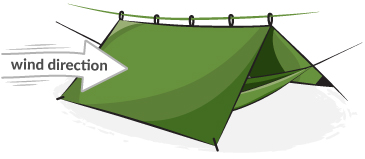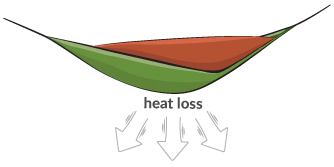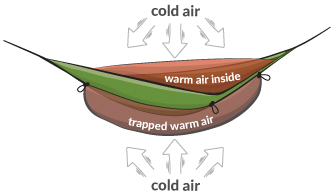Hammock Camping in Winter
Choosing your campsite
When searching for your campsite remember that with a hammock you are free from the constraints otherwise encountered with tents - no need for level ground, no ground chill, and no concern for drainage!
Top tips for wind protection
One of the most important factors in the suitability of a hammock site is how exposed it is to the wind. Search for sites with natural windblocks like dense vegetation, boulders or cliffs.

Orientation
If the wind is coming from the west, pitch the hammock north-south, and your tarp close to the ground on the windward side. This will add another layer of windblock to your hammock.
Camping on the leeward side (as opposed to the windward side) of ridges and hills can make a substantial difference. If wind isn't an issue then think about which side the sun rises – it's best to have as much daylight on you as possible.
Avoiding "cold zones"
Search for sites midway up ridges and hills. Sleeping at the top of a hill or ridge will expose you to the wind, but sleeping at the bottom will also put you in a cold zone. As warm air rises, cold air sinks to the lowest elevation, creating a "cold sink" as temperatures drop during the night.
If a stream is running along the valley floor, the temperature could be up to 4°C/10°F colder than the temperature of a site with a mere forty feet or so of elevation gain! Lakes can have the same effect, so look for sites that are slightly away from water, especially running water such as streams and rivers. Avoid setting up in areas prone to heavy dew, such as open grassy meadows on cold windless nights where all objects above the ground, including the hammock, will collect excessive condensation.
Insulation!
The biggest problem you'll face when trying to stay warm is heat loss from underneath, due to the compression of your sleeping bag and clothes caused by your body weight.

A great item to have with you is a thermarest or closed cell pad (ideally 3/4 length). This is inserted between the two layers of your hammock, and you lie on top. We recommend using a reflective pad, such as those for car windscreens; these can be found around the perfect size (large enough to cover your body area but not too large to go in the hammock, and they pack up small). Having the reflective side facing up prevents a large amount of radiant heat loss.

Alternatively, opt for an underblanket. These combat heat loss through loft compression, because they hang below your hammock and trap warm air in the space between. This, we find, is an incredibly effective insulation method and works equally as well as a thermarest (if not slightly comfier).
Layer up
Plenty of layers lock in the heat! From your clothing to your hammock rig, make sure you do just that. Numerous lightweight layers work better than a few heavy ones, so begin with thermal clothing and good quality knitwear or outdoorwear. This, along with your thermarest (or reflective pad, or underblanket) plus your sleeping bag or quilt should keep you warm inside your hammock.
Top winter tip:
This one came from one of our customers: as an alternative to a hot water bottle, use an MSR Dromedary Hydration Bag – they're similar to a hydration pack but tougher, and able to hold almost boiling water!
If it's sun and heat you're seeking on your next hammocking trip, check out our tips on camping in summer or camping in the jungle. It's also worth knowing how to set up your tarp so you're protected from monsoons and showers!
 US | USD
US | USD 


